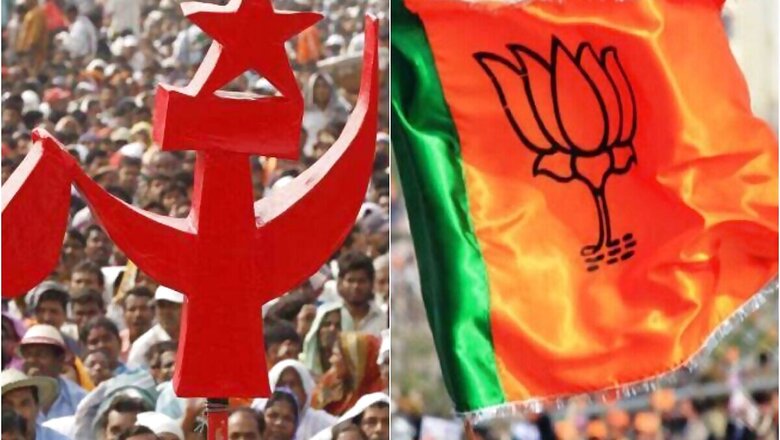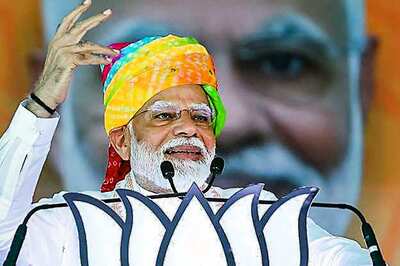
views
The Left politics of Begusarai became a prominent discussion during the 2019 Lok Sabha Elections when the constituency became a pitch of contest between the Bhartiya Janata Party (BJP) wave on one side and the ‘revival of Left politics’ on the other hand. Begusarai, referred to as the ‘Leningrad’ in Bihar as Left parties, mainly the Communist Party of India (CPI), dominated the political arena in the district from 1960s till the late 1990s. However, eventually the seat slipped to the BJP as the national-centred politics dealt a heavy blow to the Left-wing politics in the last few decades. With Kanhaiya Kumar’s loss in the Lok Sabha polls last year, the CPI’s presence in the state is nowhere to be seen.
However, under the umbrella of Grand Alliance with the Rashtriya Janata Dal (RJD) and the Congress party in the ongoing Assembly polls, the CPI is contesting on six seats of which three — Bakhri, Teghra and Bachhwara — belong to Begusarai district. The party stakes are high claiming to win at least two of the six seats.
The Begusarai district has been a stronghold for the upper-caste Bhumihar voters, a numerically and financially wealthy community in the region. Of the 19 lakh voters in the district, the Bhumihar community constitutes about 19% voters, followed by Muslims at 15% , Yadavs at 12% and Kurmis at 7%. However, in the last two decades, votes of the community has seen a gradual shift towards the BJP, giving a blow to the Left parties in the region.
One of the first references to the Left politics in Begusarai was evident in the Kedar Nath Singh vs State of Bihar, a landmark case which brought the district to limelight after Singh, previously a leader of the Forward Communist Party, had invited sedition through his speech during a rally in Begusarai, then a part of Munger district. Singh had reportedly said, “Today the dogs of the CID are loitering round Barauni (in Begusarai). Many official dogs are sitting even in this meeting. The people of India drove out the British from this country and elected these Congress goondas to the gaddi… We will strike and throw out these Congress goondas as well.” However, Singh later joined the Congress.
The Left politics in Begusarai began even before the area was carved out of Munger district in 1972. Multiple arguments have been given about the point of origin of Left politics in the area, however, the most acceptable argument is a movement started as an agitation in the late 1960s against the creation of petrochemical unit of the Barauni Refinery in the city. Ironically, it wasn’t an honest commitment to the communist ideology or a national movement, but it was rather a demand that emerged from a local context. Once protesting against the refinery, the locals today are the ones getting the profit from it in the form of contracts and private tenders.
Ram Charitra Singh from Begusarai’s Bihat village was the irrigation minister in the cabinet of former CM Krishna Sinha, the first chief minister of the state, who was affiliated to the Congress party. Singh’s son, Chandra Shekhar Singh, however, had rebelled against his father’s political choice and founded the Communist Party of India (CPI) in Begusarai. Chandra Shekhar then won the Assembly By-poll in 1962 from Begusarai’s Teghra constituency, which became a stronghold of Left politics in the region as CPI legislators from the Assembly got elected for more than four decades (1962 to 2010) at a stretch, which is a record in itself.
After winning twice — in 1967 and 1996 — the CPI was left on its own in 1967 when party leader Yogendra Sharma won the Lok Sabha seat. In 1996, the party came in a grand alliance with RJD president Lalu Prasad Yadav and won the Lok Sabha elections after a long time with party leader Ramendra Kumar in the fray. The seat, however, went to RJD in 2010 and during the 2015 Assembly polls, BJP candidate Ram Lakhan Singh defeated CPI’s Ram Ratan Singh.
However, during the post-emergency period, socialist politics started picking up in the state, replacing the Left politics due to the culture questions it raised. “Socialist politics raised questions which the communists never addressed. Ram Manohar Lohia addressed the question of culture, local issues, language. Socialists were more connected to the local issues, which concerned local people. Where the socialists found space, the left politics receded because of the cultural question,” said Ajay Gudavarthy, a political science teacher at the Jawaharlal Nehru University (JNU).
The argument was seconded by Rajendra Singh, four-time MLA from Teghra constituency, who said that the BJP focussed on class issues rather than culture or language issues, and had been focussing primarily on instilling ‘Hindutva’ in the country. “BJP has been trying to stir sentimental issues, be it the Ram Mandir issue, communal issues or any other such issue. The BJP has been focussing on Hindi-Hindu and Hindutva. But this isn’t going to last for long time,” he said.
The socialist politics and later the rise of BJP in other parts of the country transformed the political equations in the region. According to Gudavarthy, the class politics by the BJP occupied the influence of the Left in the state. “BJP’s way of mobilisation, its anti-system, anti-elite politics broke the equations which once existed during the left. BJP picked up the issue of local language, local symbol and uncivil strategies which a majority shared in their everyday reality. Its mobilisation on ground appealed to the audience,” he said.
The shift from Left to right-wing politics in Bihar could be personified in some leaders who shot to fame during the period. Late BJP MP Bhola Singh, who belonged to the influential Bhumihar caste, began his career as a left-supported Independent MLA in 1967 and won the first legislative assembly election from Begusarai in the same year. He was elected eight times from the Begusarai assembly seat since 1967 and was also formally elected as a CPI MLA in 1972.
However, with the downfall of communist politics in the state, Singh shifted to BJP and made a start by successfully contesting from Nawada district in 2009. During the 2014 Lok Sabha Elections, Singh contested on a BJP ticket from the Begusarai seat and defeated the RJD and CPI candidates. The seat, which had never been won by the BJP on itself, was taken over from the Left. After Singh’s death, another Bhumihar, Giriraj Singh won the seat in 2019 with a landslide victory.
The Bhumihar domination in the region could be gauged by the fact that MPs in the seat have always belonged to the caste group, irrespective of the party. The only exception was in 2009, when the seat was allotted to JD(U)’s Monazir Hasan, who had successfully contested the election with BJP’s support.
During the 2019 Lok Sabha polls, CPI candidate Kanhaiya Kumar, who belonged to the Bhumihar caste, was a last hope for the Left party to regain its lost grounds in the region. However, Kumar lost the seat to BJP’s Giriraj Singh who, on the other hand, won with a huge margin of 3.5 lakh votes.
CPI had asked RJD for the Begusarai seat, but the RJD had refused. RJD’s Tanveer Hasan, who had earlier lost with around 55,000 votes to Bhola Singh in 2014, stood third with around 2 lakh votes. “Our only mistake during the Lok Sabha election was that the election got out of our hand. We had no control over who was leading or campaigning for us. BJP fought it on polarisation. The faces that were campaigning for Kanhaiya from the front consolidated the Bhumihar votes for Giriraj Singh,” said a senior party leader on the condition of anonymity.
However, the left parties defending the allegation of losing out on the turf gives an argument that the party still holds a share in the ongoing Assembly election. According to Rajendra Singh, the party is active and has cadres in all the 38 districts in Bihar. He said that the communist parties and other opposition parties need to ramp up their coalition in order to revive their performance during the elections.
The Left parties have disciplined cadres mainly in Jehanabad, Barauni-Begusarai, Mithila, Siwan and Champaran regions of the state. However, CPI had won just one seat in Begusarai’s Bachwara in 2010 Assembly elections and did not win even a single seat in the 2015 polls, while the CPI-ML (Liberation) had won three seats during the last Assembly polls.
The fall of the left parties in the state could be alluded to the rise of socialist politics and later the saffron wave in northern parts of the country or it could be concluded that with the global decline of communism, left politics withered with time.
Read all the Latest News and Breaking News here



















Comments
0 comment